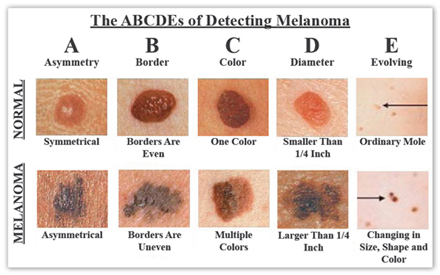SCALP MELANOMAS ARE MORE LETHAL THAN ANY OTHER TYPE

Melanoma is the most dangerous type of skin cancer. It is derived from melanocytes, the skin’s pigment cells, and can spread quickly (metastasize) through the lymph nodes or bloodstream if not detected at an early stage.
Of the lesions that develop in the head and neck region, most melanomas arise in the face (47%). The remainder are found on the neck, which accounts for 29%, the scalp (14%), and the ear (10%). In addition, approximately 55% of mucosal melanomas are found in the head and neck. The most deadly are on the scalp, head and neck areas.
Scalp melanomas are more lethal than other melanomas. Why are scalp melanomas more lethal? One reason may very well be a delay in diagnosis because of their location, in an area usually hidden by hair, where one cannot see them without some effort.
Risk Factors
Many risk factors for melanoma have been identified. The most important risk factor is exposure to sunlight, particularly UV-B radiation. Recent studies suggest that cutaneous melanomas of the head and neck are significantly more likely to occur in people with high levels of total sun exposure. Conversely, melanomas on the trunk tend to develop on people with lower levels of ambient sunlight exposure, but who also experience higher levels of recreational exposure on the chest and back. Sunburns early in life and exposure to UV radiation from tanning beds are other factors in the development of melanoma. People who burn easily, such as those with fair or red hair, blue eyes, and light-coloured skin, are most prone to develop melanoma. The presence of freckling also indicates an increased risk for melanoma development
How Can Hair Stylists Help?
Hair professionals are in a unique position to detect skin cancers on the scalp because they have a natural view of its difficult-to-see areas during a salon visit. They see their clients on a regular basis, and may frequently discuss health-related topics, such as wellness, illness, diet and medical care.
Identifying Melanoma
The A.B.C.D. rule has been very effective at aiding the early identification of superficial spreading melanomas. Superficial spreading melanoma can have any one of the following criteria.
- Asymmetry – The shape of one half does not match the other.
- Border – The edges are often ragged, notched, blurred, or irregular in outline; the pigment may spread into the surrounding skin.
- Colour – The colour is uneven. Shades of black, brown, and tan may be present. Areas of white, grey, red, pink, or blue also may be seen.
- Diameter – Size changes and usually increases. Typically, melanomas are at least 6mm in diameter (the diameter of a pencil).
The E.F.G. rule
There is a class of rapidly growing, nodular melanoma, which represent about 20% of all cases of melanoma. This type of melanoma does not subscribe to the ABCD rule and thus can go undetected. Fortunately, they do behave in a way that allows them to be identified early using the E.F.G. rule. Nodular melanoma usually have all three of the below criteria.
- Elevated
- Firm
- Growing
The moles don’t need to be dark or have any other colour to them, but the key giveaway is that they are raised, often very symmetrical, are firm to touch, and most importantly are changing/growing progressively. In the early stages, this change might just be a sense of change rather than visible – perhaps the mole is itchy, or just feels funny. This type of melanoma can affect anyone, but is generally much more common in men over 50. The frightening thing about nodular melanoma is that because they are growing fast, they can go deep very quickly (within a few months), which is why they are so dangerous and need early diagnosis and removal.
More Info
Melanoma does not always fit the A.B.C.D. or E.F.G. rules described above. If you notice a lesion that is:
- different from others (The Ugly Duckling);
- changing in shape, size or colour;
- a new skin lesion or
- itches or bleeds
You should bring it to the attention of your doctor immediately, accurately describing the symptoms and your reason for concern.
Book in for your complimentary Hair & Scalp diagnosis and discover the secret to a healthy scalp & beautiful hair.

